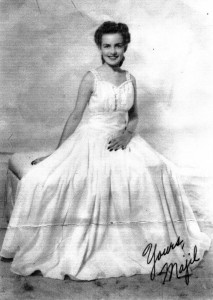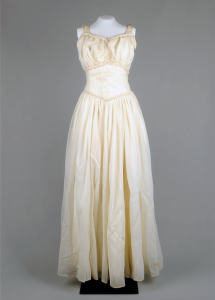By Andrea Hoffman, Collections Manager

Majil Steiner wearing the parachute gown.
On November 21, 1944, the B-29 “Snafuperbomber” with the 40th Bomb Group was attacked over Japan while approaching its target city of Omura. While badly damaged, the crewmembers managed to keep the B-29 airborne back across the China Sea. But when the aircraft’s usable fuel supply began to run low, the crew was forced to bail out over Japanese-occupied territory in eastern China, the order to jump coming from the aircraft commander as they approached a valley filled with rice paddies. 1st Lt. Floyd “Dick” Steiner, the aircraft’s navigator, was quickly rescued by local farmers and smuggled back to safety. Steiner kept his parachute and ripcord throughout the ordeal, and upon returning to his base in Chakulia, India a few days later, mailed it home to his wife, Majil, back in Eau Claire, Wisconsin. Along with the parachute came his request that she reuse the material to make a new dress for herself.
As Majil later recounted, “When the box arrived I opened it, and with amazement pulled out the roomful of nylon parachute.” As an only recently-developed synthetic reserved for military usage during the war, nylon was still a novelty in the mid-1940s. The silk-like panels were carefully taken apart by her and her friends so that the cloth could be reused for her gown design. Unfortunately, the dress would also require a sturdy lining fabric, something essentially unavailable given wartime limitations. Majil was not deterred, however, and sought help finding it from a fabric company in St. Paul, Minnesota. The company wound up taking an interest in her husband’s story and the dress project and soon mailed her several yards of the required lining material.

V2015.09.1 Majil Steiner’s parachute gown.
With the further assistance of an experienced dressmaker, as well as a rug maker who taught Majil how to braid the shoulder straps out of the parachute’s cords, her evening dress was completed in 1945. She had a portrait taken of her in the dress, and mailed it off to her husband in India. He carried the photograph of her wearing the life-saving parachute material on him for the rest of his tour. The couple, now married 71 years, has since moved out west, but recently returned the dress to its home state of Wisconsin by donating it to our museum’s permanent collection.

